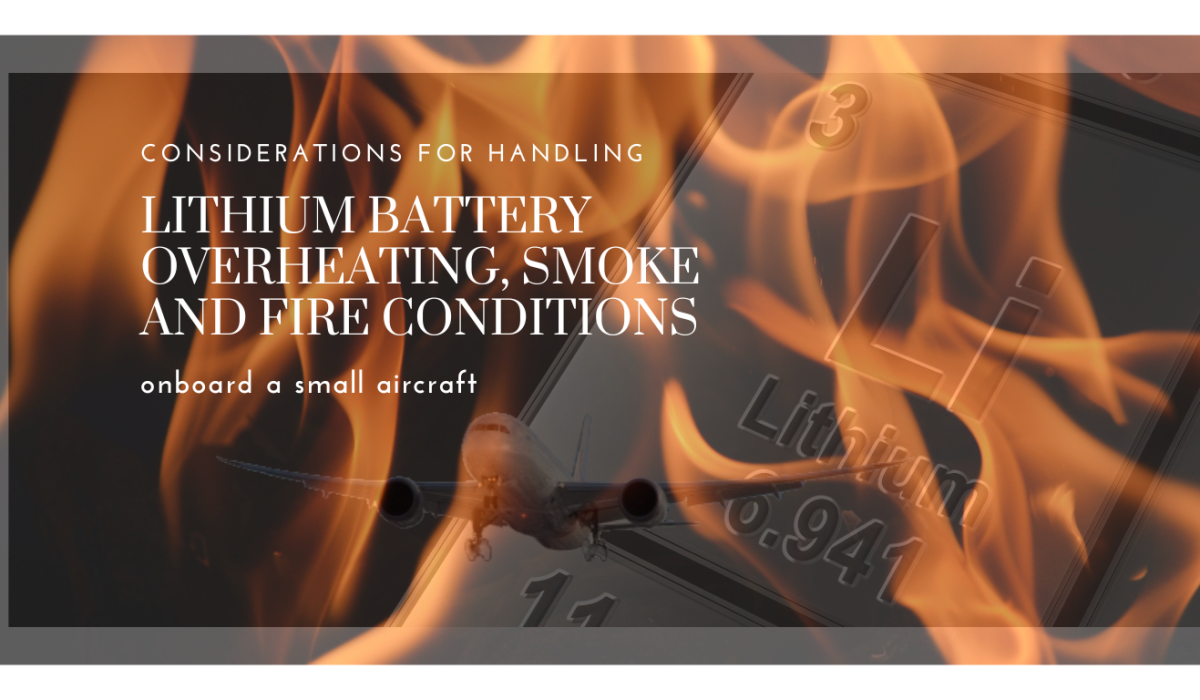Lithium Battery fire and overheating conditions
Our safety specialists discuss
Table of Contents
1. Introduction:
Today lithium batteries play a barely visible, yet essential role in both our daily life and aviation alike. Manufactured and handled correctly, lithium batteries are safe. But production failures, mishandling, or not being aware of their specific characteristics can have serious repercussions. According to the FAA, there were 57 lithium battery incidents on flights in 2022 alone.
The main purpose of the following document is to point out some important considerations when facing a lithium battery fire or overheating condition onboard a small or charter aircraft (e.g. Part 127/135 Operation) when there is no cabin crew available onboard. It will focus specifically on lithium battery fire or overheating conditions in the flight deck, cabin or baggage compartments caused by lithium batteries from crew or passengers’ cell phones, laptops or power banks, not when it is carried as air cargo/freight in dedicated cargo compartments with active fire suppression systems, as these smaller aircraft types are usually not equipped as such. Hopefully, this document will create a discussion point for every operator to see if they have adequate procedures, training, and awareness in place for their crew to deal with such a scenario onboard. The information documented is sourced from various online websites and published documents. It is only a small extract of information available in the industry on this subject.
2. Background:
Virtually every air traveller is carrying a device powered by a lithium battery, and most passengers are travelling with more than one such device. It’s not that any specific lithium battery is at a particularly high risk of a thermal runaway resulting in a fire, it’s the sheer number of batteries being carried onboard aircraft that creates the risk. Hundreds of millions of lithium batteries or equipment with lithium batteries are carried on aircraft annually.
These can be as part of passengers’ carry-on items, as aircraft (e.g. Portable IFE, defibrillators) or aircrew equipment (such as Electronic Flight Bags). They can be shipped as cargo in battery form or within other purchased items, or as a power supply for aircraft equipment.
Examples of lithium batteries onboard an aircraft:
Several events have occurred on aircraft, ranging from localized and limited fires to large, uncontrolled in-flight fires. The air industry has become more aware of the specific characteristics of lithium batteries and the associated risks. Procedures have been developed to address and mitigate the risks. Operators must ensure that their crews are familiar with these procedures.
Experimentation with lithium batteries began in 1912 and the first lithium batteries were sold in the 1970s. In the nineties, lithium battery technology began to be widely used by several industries that were looking for light, powerful, and durable batteries. Lithium is the metal with the lowest density, but with the greatest electrochemical potential and energy-to-weight ratio, meaning that it has excellent energy storage capacity.
This large energy density and low weight characteristics make it an ideal material to act as a power source. Lithium batteries progressively replaced previous technology batteries – e.g. Nickel-Cadmium, Lead-acid – and can be found in most electronic and autonomous electric systems or equipment.
3. Different Types Of Lithium Batteries:
Lithium batteries can take many forms. They can be as tiny as single-cell button batteries – for example, used as power supply for watches – or multi cells (usually rechargeable) batteries that can act as high-power energy sources for electric vehicles, or indeed as a backup power supply onboard the aircraft. The term “Lithium battery” actually refers to a family of batteries that can be divided into two categories:
Primary: Lithium-metal, non-rechargeable batteries. These include coin or cylindrical batteries used in calculators, digital cameras, and emergency (backup) applications for example. Lithium-metal batteries have a higher specific energy compared to all other batteries, as well as low weight and a long shelf and operating life.
Secondary: Lithium-ion / Lithium-polymer rechargeable batteries. The key current application for this type of battery is the powering of cell phones, laptops, or other hand-held electronic devices, as well as electric/hybrid cars and power stores. The advantages of the Lithium-ion or Lithium-polymer battery are its ability to be recharged in addition to its higher energy density and lighter weight compared to nickel-cadmium and nickel-metal hybrid batteries.
4. New Battery Technologies Being Developed:
Researchers have developed a new method for producing a key component of lithium-ion batteries. The result: More affordable batteries from faster and less wasteful processes that use less toxic material. Lithium-ion batteries are composed of a cathode and an anode with an electrolyte in between. Ions move from anode to cathode through the electrolyte in a reaction that converts chemical energy to electrical energy.
Researchers report that they have developed cleaner, cheaper, and more efficient methods for making a new class of high-capacity cathode material without cobalt. These novel processes offer the key advantage of moving the cathode industry to cleaner and more cost-competitive production while putting less burden on the environment.
- Room temperature sodium-sulphur batteries are a promising alternative for renewable energy storage. They rely on chemical reactions between a sulphur cathode and a sodium anode to store and deploy electrical energy, and they use low-cost materials, which can even
be easily extracted from saltwater. - Another type is aluminium-sulphur batteries. The three main ingredients are aluminium, no different from the foil at the supermarket; sulphur, which is often a waste product from processes such as petroleum refining; and widely available salts. The ingredients are cheap and safe, and they cannot burn.
- NanoBolt lithium tungsten batteries. Recharging the battery is much faster, and it also stores more energy.
- Zinc-manganese oxide batteries.
- Organosilicon electrolyte batteries.
- Gold nanowire gel electrolyte batteries.
- TankTwo String Cell batteries.
- Solid-State batteries. The thermal stability of the solid-state designs promises little or no chance of a thermal runaway, which has made current lithium batteries synonymous with fire risk.
However, lithium-ion batteries are far from done. The graphite anode that forms a lot of the bulk and about 15% of the weight of today’s lithium-ion batteries is being replaced with a form of silicon that claims it will give battery cells a 20 to 40% increase in energy density while also charging faster. For now, we may have to put up with phones going cold, and laptops getting hot however, solutions seem to be on the horizon with a better battery-powered future within sight.
5. The Thermal Runaway:
As with every new technology, lithium batteries offer several advantages, but they also come with limitations. Although previous battery technologies were not risk-free, lithium-based batteries have a larger electrochemical potential, therefore if damaged, mishandled or poorly manufactured, they can suffer stability issues and can be subject to what is called a “thermal runaway”. This phenomenon is well recognized now, and it can be mitigated by providing awareness and preventive actions are taken. Recognizing the warning signs of a failing lithium battery is paramount to preventing a fire. Unusual heat, noise, smoke, odour, or swelling are all indications that the battery is failing.
A thermal runaway consists of an uncontrolled energy release. It refers to a situation where an increase in temperature changes the conditions in a way that causes a further increase in temperature, often leading to a destructive result. In multi-cell batteries, the thermal runaway can then propagate to the remaining cells, potentially resulting in the meltdown of the cell or a build-up of internal battery pressure resulting in an explosion or uncontrolled fire of the battery.
In case of internal degradation or damage, a battery cell rapidly releases its stored energy (potential and chemical) through a very energetic venting reaction, which in turn can generate smoke, flammable gas, heat (up to 600°C and 1000°C locally), fire, explosion, or a spray of flammable electrolyte. The amount of energy released is directly related to the electrochemical energy stored and the type of battery (chemic and design). Both the primary and secondary types of batteries are capable of self-ignition and thermal runaway. And once this process is initiated, it easily propagates because it generates sufficient heat to induce adjacent batteries into the same thermal runaway state. Lithium batteries can be both a source of fire through self-ignition and thermal runaway and a cause of fire by igniting surrounding flammable material.



The main factors contributing to a thermal runaway are:
- Poor design or poor integration.
- Poor cell or battery manufacturing quality.
- Poor safety monitoring or protection, overcharging.
- Poor handling/storage/packing / damaging conditions.
The phenomenon of thermal runaways in an aircraft environment can be catastrophic. At the least, it can range from limited degradation of personal equipment, or minor damage to the overhead storage compartment. In the case worst situation, a thermal runaway in a high-density package of lithium batteries can result, and has been implicated, in hull losses. FAA tests show that even a small number of overheating batteries emit gases that can cause explosions and fires that cannot be prevented by traditional fire suppression systems.
Given the possible consequences, lithium batteries are classified as hazardous materials, therefore particular care and consideration must be taken to ensure safe operations concerning the use and transport of lithium batteries (or devices containing lithium batteries) when in an aircraft environment.
6. Migrating The Risks:
Although the investigation into reported events highlighted that some lithium battery fires were due to internal short circuits relating to design, manufacturing, or integration shortcomings, many – if not most – fires were caused by abuse by the user. This may be deliberate or negligent abuse or physical damage due to mishandling, but quite often it is unconscious abuse.
Also, while strict regulations for transporting lithium batteries as cargo exist, several incidents have been related to lithium batteries being in the cabin. For this reason, a good awareness of the risks posed by lithium batteries to both the operator’s personnel and passengers is crucial.


6.1 Step 1: Awareness and General Considerations:
Ground personnel and flight crew must be fully aware of the Provisions for Dangerous Goods Carried by Passengers or Crew as documented in the IATA Dangerous Goods Regulations, Subsection 2.3, Table 2.3.A.
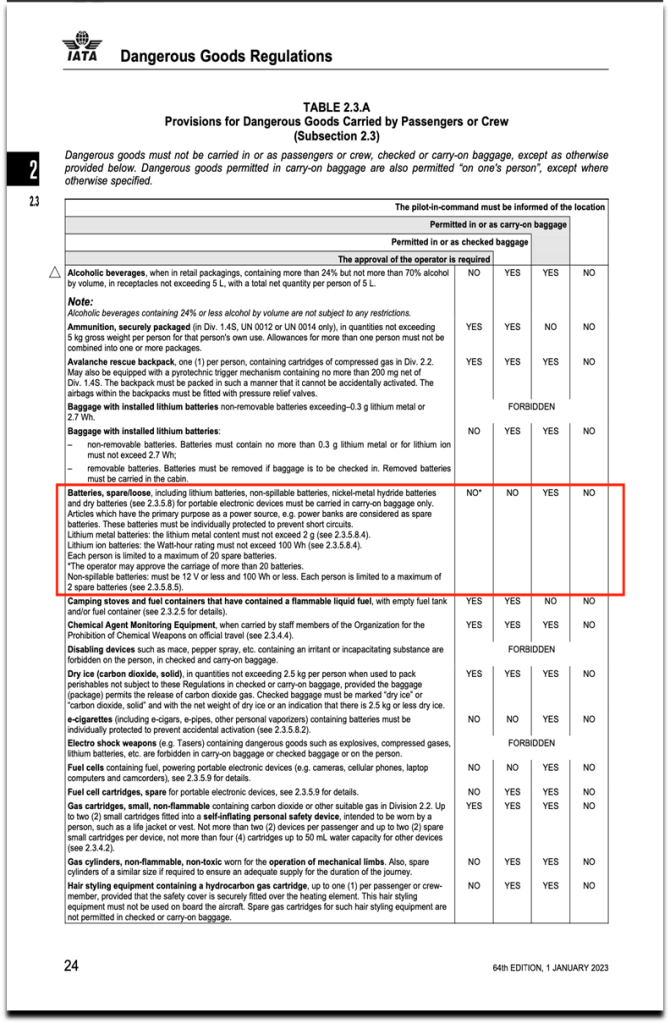
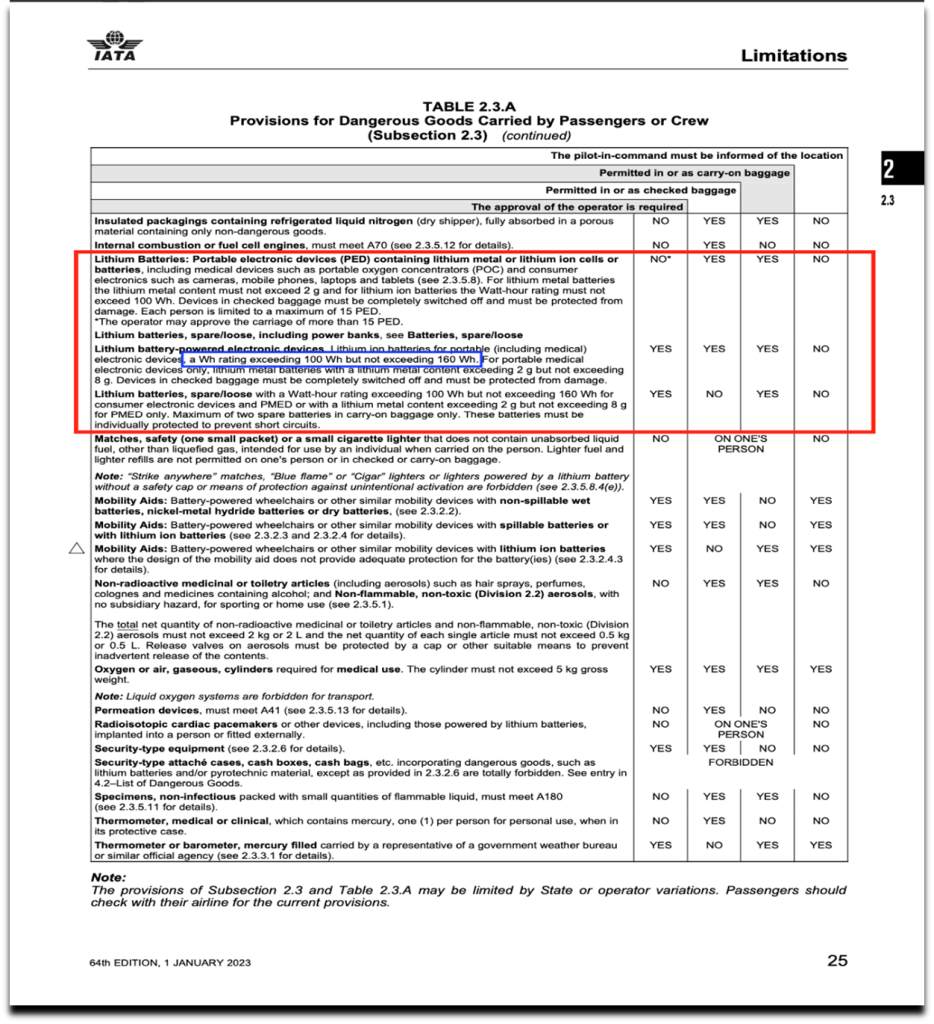
Wh – Rating: Airplane passengers carrying the usual assortment of phones, cameras, tablets, and ereaders are well within the airline industry’s safety limit for lithium-ion batteries of 100 watt-hours for each device. This figure measures how much energy the battery can hold as well as how much energy it can deliver over time. Given the potential for lithium-ion batteries to catch fire, the difficulty in extinguishing such a blaze, and the toxic fumes a burning battery emits, the airline industry is wary of batteries rated higher than 100 watt-hours, which is typically written as 100 Wh.
A battery in a smartphone might be only about 12.4 watt-hours. But professional broadcast cameras, batteries for power tools, and even some extended-duration laptop batteries can exceed 100 watthours. Those are allowed in the cabin of airliners up to a maximum of 160 watt-hours and only under certain conditions.
Usually, this means the battery must be installed in the device it is powering and show no signs of damage. Terminals on spare batteries must be taped or otherwise protected to prevent shortcircuiting that can lead to a fire or explosion. Portable chargers are also considered spare batteries and can travel only in passenger carry-ons — not in checked luggage where a fire could go undetected.
Newer batteries may show the watt-hours, as Wh preceded by a number, but not all are marked this way. Calculating the watt-hours based on the information printed on the outside of a battery is not difficult. Multiply the given volts by the battery capacity, shown as milliamps or mAh. Divide the sum by 1,000 to get the watt-hour rating. Drones, which are increasingly popular and were expected to be an in-demand holiday gift, can require relatively powerful batteries.
Cargo Compartment Classifications: Cargo compartments are classified in most national airworthiness requirements in Classes A – E. Class A is a cargo or baggage compartment in which the presence of a fire would be easily discovered by a crew member while at his or her station and each part of the compartment is easily accessible in flight. Typically, Class A cargo compartments are small cargo compartments that may be located between the flight deck and the passenger cabin or
adjacent to the galley area, or at the back of the aircraft. This is mostly applicable to the smaller aircraft in the Part 135 operations which is the focus of this document. As the smaller aircraft usually don’t have overhead storage areas (bins), the passenger’s hand luggage (containing permitted dangerous goods – refer to Table 2.3.A) is then often placed in the cargo compartment which is located inside the cabin as described above. For the definitions of all other classes of cargo compartments, refer to ICAO Doc 9481.
Land ASAP: When assessing an appropriate course of action to take in the event of an incident involving any dangerous goods, including lithium batteries, consideration should always be given to landing as soon as possible. If the situation permits, the relevant air traffic services should be informed of the dangerous goods or situation on board.
Fires, Smoke, and Fumes: In-flight fires left unattended, particularly those that are not readily accessible, may lead to catastrophic failure and have resulted in the complete loss of airplanes. Studies have also shown that flight crew may have as few as 15–20 minutes to get an aircraft on the ground if the crew allows a hidden fire to progress without any intervention. These studies and other experiences indicate that flight crew members should begin planning for an emergency landing as soon as possible after the first indication of fire. Delaying the aircraft’s descent by only a couple of minutes might make the difference between a successful landing and evacuation, and the complete loss of an aircraft and its occupants. Smoke and fumes may be one of your first indications of an impending fire. Never ignore a strange odour, you need to take action and identify its source as soon as possible.
Aircraft Emergency Response Drills: The aircraft emergency response drills as shown in Table 4-1 of ICAO Doc 9481 ( Emergency Response Guidance for Aircraft Incidents Involving Dangerous Goods) are for the guidance of crew members when an incident occurs in flight which is, or might be, related to a particular package, or packages, containing dangerous goods.
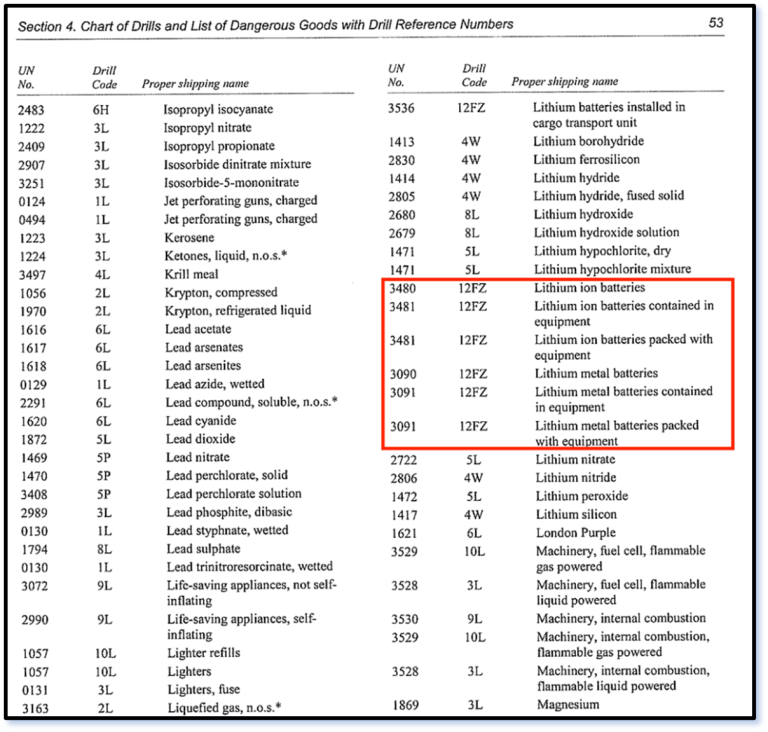

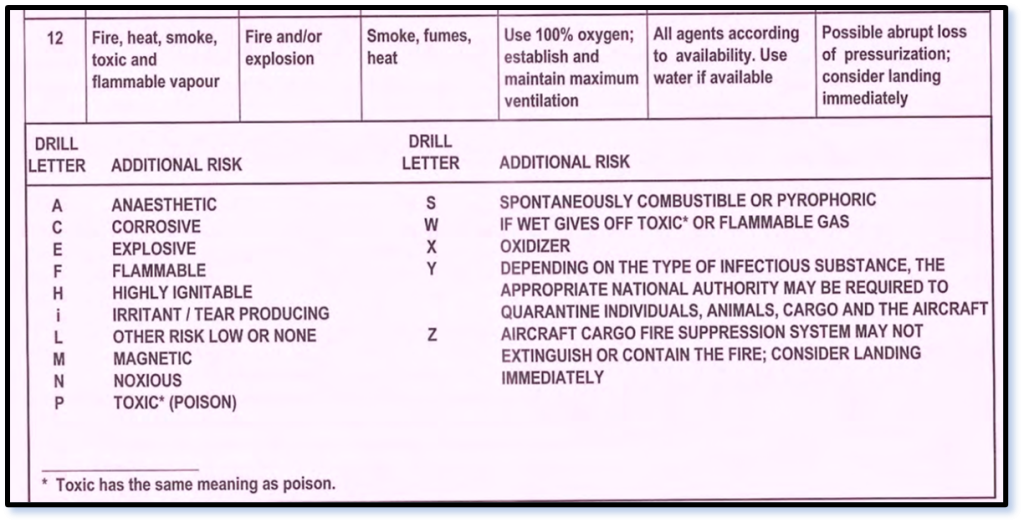
6.2 Step 2: Procedures:
For procedures dealing with a dangerous goods incident on board an aircraft, refer to ICAO Doc 9481 Section 3 for checklists and guidance step by step. Section 3.3.1 – 3.3.4 references the procedures to follow by the cabin crew in the passenger cabin during the flight when an incident occurs concerning a battery/portable electronic device (PED). Although the focus of this document is mainly on operations on aircraft without any cabin crew, the basic logic/concept of the procedure remains the same. Because lithium-ion batteries are on board every aircraft, we need to ask ourselves how we are going to handle these emergencies.


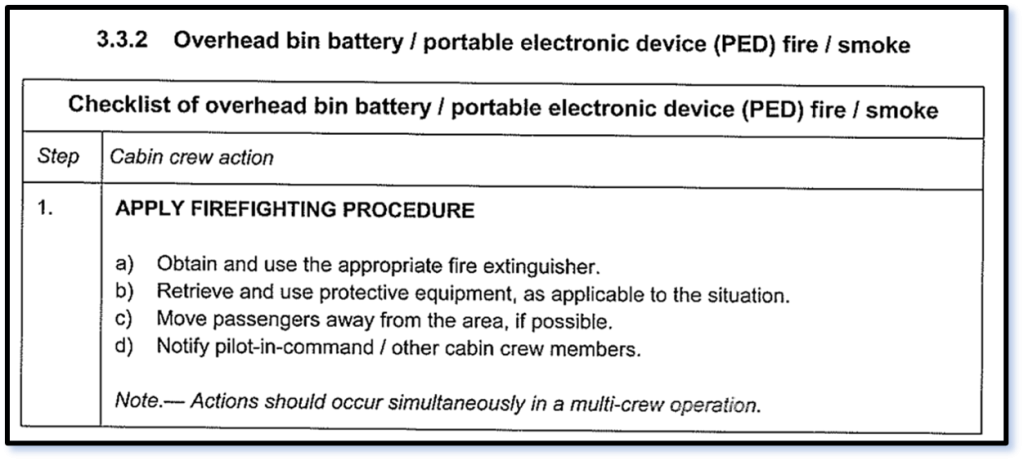
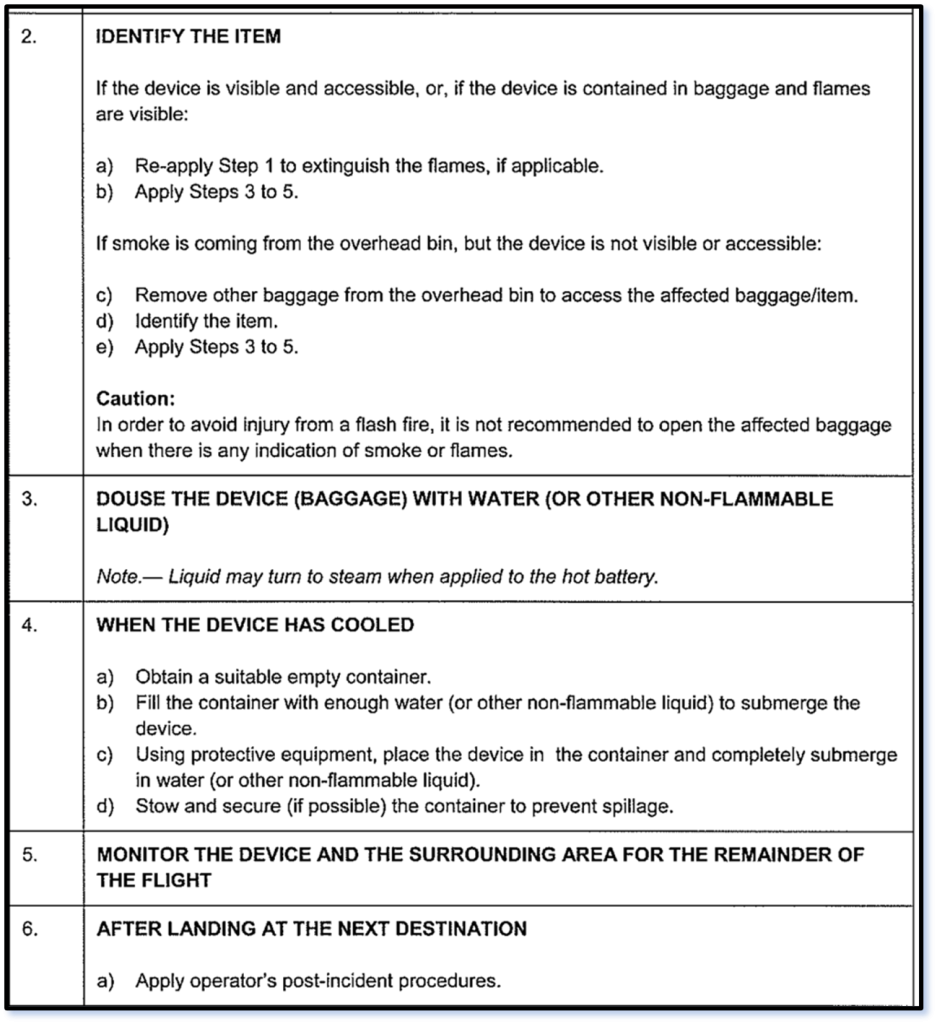
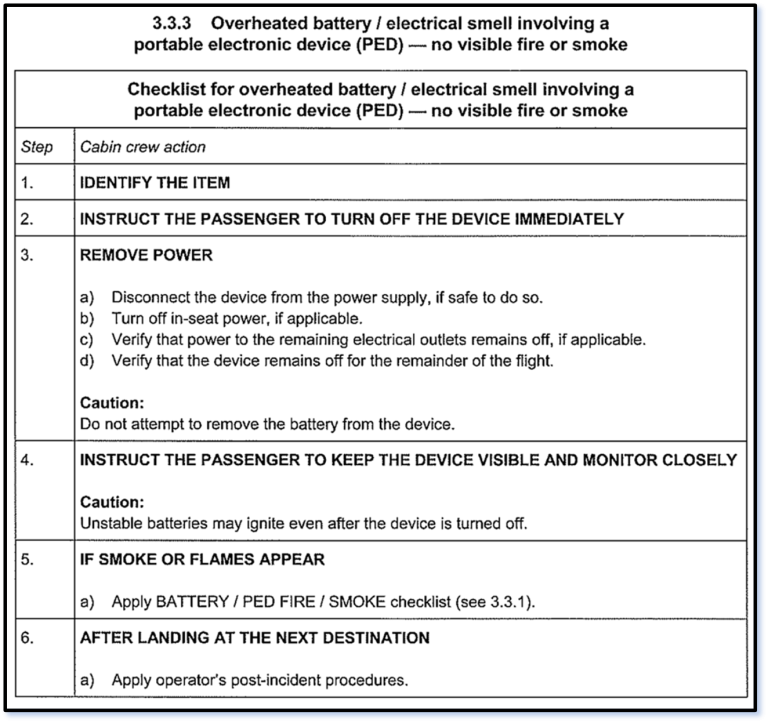
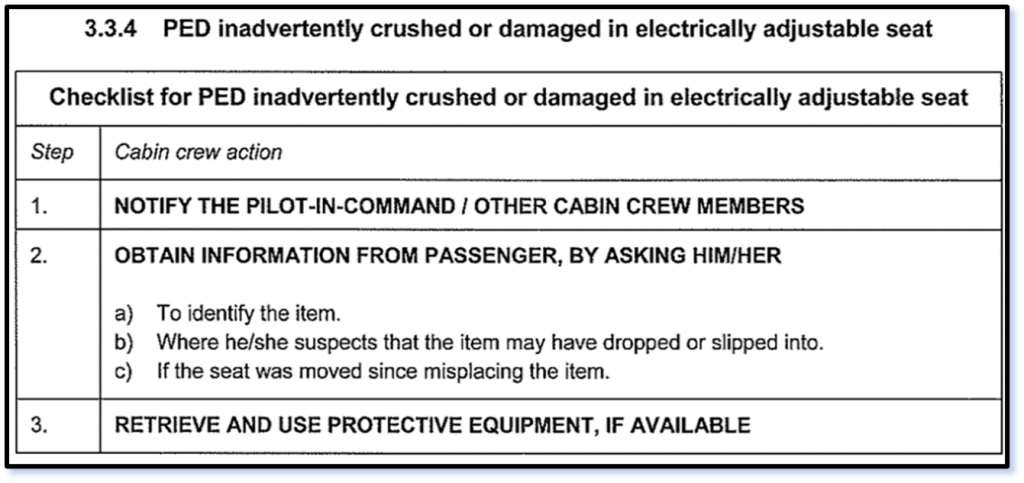
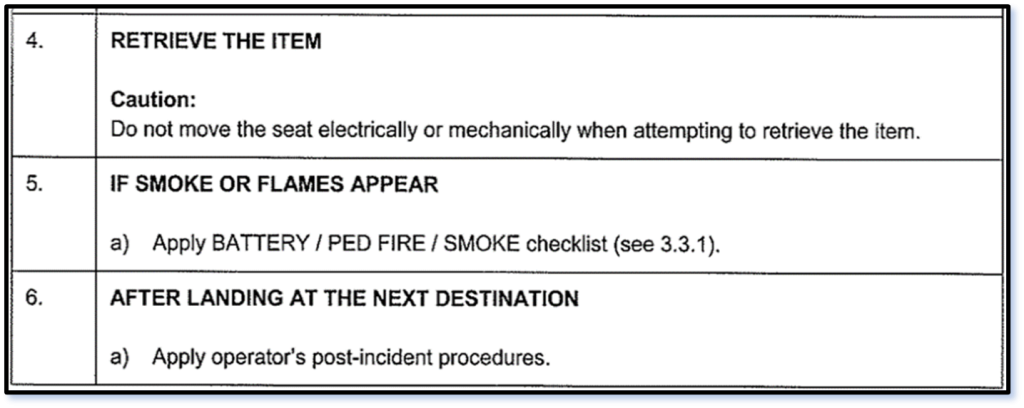
Refer to FAA Advisory Circular (AC) 120-80A dated 22 December 2014 and SAFO 09013: This AC summarises and documents the main important steps to follow. The following procedures are recommended for fighting a fire in a lithium-type battery-powered PED.
PROCEDURES:
PASSENGERS: Relocate passengers away from the device.
EXTINGUISHING THE FIRE: Utilize a halon, halon replacement, or water extinguisher to extinguish the fire and prevent its spread to additional flammable materials. Immediate and aggressive action, when confronted with a potential fire, is much more important than delaying while you attempt to classify a particular fire. Upon discovering a fire, the initial focus should be on aggressively extinguishing the fire with a readily available extinguisher.
COOLING THE REMAINING CELLS TO STOP THERMAL RUNAWAY: After extinguishing the fire, douse the device with water, an aqueous-based extinguishing agent, or other non-alcoholic liquids to cool the device and prevent additional battery cells from reaching thermal runaway. Therefore it is recommended to continue the application of water or other non-flammable aqueous substance for a period of at least 15 minutes after a fire has been extinguished or the smoke has dissipated. A cooled device may then be placed in a receptacle including a containment product
WARNING:
Crewmembers should exercise extreme caution when approaching an electronic device that is overheated, smoking, deforming, or is on fire, indicating that a thermal runaway has already occurred.
Do not attempt to pick up and move a smoking or burning device! You may be injured.
Do not cover the device or use ice to cool the device. Ice or other materials insulate the device, increasing the likelihood that additional battery cells will reach thermal runaway.
Do not use fire-resistant burn bags to isolate burning lithium-type batteries. Transferring a burning appliance into a burn bag may be extremely hazardous. Do not move the device until you are certain the fire is extinguished, and the device is cool.
Smoke, fire, or fumes checklists should include, as the first step, that flight crew members don their oxygen masks and verify that the regulator is set to 100 percent. Flight crew members must don smoke goggles and oxygen masks at the first indication of smoke or fumes and before accomplishing any abnormal or emergency procedures associated with smoke or fume elimination per your company’s approved procedures and/or the manufacturer’s recommendations. Any delay might result in crewmembers’ inability to breathe and/or see.
If additional crewmembers, especially flight crew members, are required to assist in fighting a cabin fire, the FAA recommends they don PBEs before leaving their duty station.
Unpressurized aircraft should descend at the maximum safe rate to the minimum practicable altitude to avoid hypoxia resulting from the agent displacing oxygen from the air and to minimize exposure to halogenated agents.
6.3 Step 3: Equipment:
Damaged lithium-ion batteries in portable electronic devices (PEDs) can overheat quickly, leading to an increased potential for fires. Airline personnel can use battery fire containment products to mitigate fires and damage from thermal runaway events during flight. A growing industry concern, however, is knowing which fire containment products are effective and will meet their respective performance claims.

Containment devices/Burn bags
Manufacturers have stated in their advertisement and marketing videos that their products “are FAA certified,” “have been successfully tested by the FAA,” or “meet FAA standards.” However, the Fire Safety Branch of the FAA Technical Centre and the Aircraft Certification Service emphasize that there are no testing standards for these containment products, nor is there a mechanism in place for the approval of these products.
The UL 5800 Standard and accompanying test methods were developed to address the risks of thermal runaway events and standardize the performance of fire containment products. ANSI/CAN/UL 5800, the Standard for Safety for Battery Fire Containment Products, is a voluntary, binational document currently recognized by Canada and the United States and was published in December 2020. It provides test methodology and performance criteria to evaluate products used to contain Personal Electronic Devices (PEDs) in the event of a battery fire. The Standard is currently limited to PEDs on passenger flights but may be expanded in the future. While the Federal Aviation Administration (FAA) has not developed test standards for these containment products, UL 5800 certification confirms a product meets specific performance requirements.
The FAA cautions against putting lithium batteries in containment bags. Not all bags are airtight and the smoke can still escape, but more importantly, putting the device inside the bag can trap the heat, making the chemical reaction worse. It is thus very important to cool the device down as much as possible before putting it into the containment bag.
FAA Notice N8900.430 states that the FAA has no objection to the use of the various commercially manufactured containment products, provided the procedures recommended in FAA guidance are followed. Researchers and aerospace engineers were presented with a series of questions on the use of fire containment products and concluded that containment devices should not be used in an attempt to extinguish a PED fire due to the dangers associated with picking up the PED while the device is in an unstable condition (i.e., the fire is still actively burning or the device appears to be expanding or popping from heat). A fire in one cell of a battery may not have propagated to other cells. However, if the device is hot, the potential for propagation exists; therefore, the device should not be moved until thoroughly cooled. Manufacturers of certain containment bags may recommend that a pilot move a burning, smoking, or hot device associated with a lithium battery, the FAA continues to recommend that all crewmembers not move any device that is burning, smoking, or exhibiting any evidence of overheating until that device has been thoroughly cooled.
ANG-E21, IATA, ICAO, and Flight Safety Foundation (FSF) guidance materials also stress that a malfunctioning PED should not be handled by personnel. Guidance for operators to consider when incorporating containment kits includes the current editions of:
- Safety Alert for Operators (SAFO) 09013, Fighting Fires Caused by Lithium Type Batteries in Portable Electronic Devices, and supplement.
- AC 20-42, Hand Fire Extinguishers for Use in Aircraft.
- AC 120-80, In-Flight Fires.
- IATA Cabin Operations Safety Best Practices Guide, Appendix A, Cabin Crew Checklist for Fires Involving Batteries and Portable Electronic Devices (PED).
- IATA Lithium Batteries Risk Mitigation Guidance for Operators. • IATA Lithium Battery Toolkit, available at http://www.iata.org/whatwedo/cargo/dgr/Pages/lithium-batteries.aspx.
- EASA SIB No: 2022-08 dated 12 October 2022.
- FSF Lithium Battery Overheating Flight Crew Guidance, available at https://flightsafety.org/flight-safety-foundation-publishes-flight-crew-guidancelithiumbattery-overheating/.
- ICAO Doc 9284, Technical Instructions for the Safe Transport of Dangerous Goods by Air, available at http://www.icao.int/Pages/default.aspx.
- ICAO Doc 9481 AN/928, Emergency Response Guidance for Aircraft Incidents Involving Dangerous Goods (refer to the Examples of Dangerous Goods Incidents Checklists).
- Lithium Batteries Guidance for Crew Members, available at https://www.youtube.com/watch?v=Ayib3f6rqPs (starting at 11:10).
Once the fire is extinguished, containment devices can be used to secure the PED utilizing the procedures that are specified in SAFO 09013, AC 20-42, and AC 120-80, provided the PED has been adequately cooled to allow transfer to the containment device. Always use Heat Resistance/Fire Protection Gloves when moving the device. Keeping an unstable device cool is critical. To do so, any such containment device should be capable of holding liquid so that the device can be submerged during storage. Also refer to the IATA Cabin Operations Safety Best Practices Guide, Appendix A, Cabin Crew Checklist for Fires Involving Batteries and Portable Electronic Devices (PED).

Fire Extinguishers
Lithium-ion battery fires are Class B fires, indicating the presence of flammable liquids, so a standard dry chemical or ABC extinguisher can put them out.

Class B fires involve flammable and combustible liquids such as gasoline, alcohol, oil-based paints, and lacquers. Therefore, extinguishers with a B rating are designed to extinguish fires involving flammable and combustible liquids. An extinguisher with an ABC rating is suitable for use with fires involving ordinary combustibles, flammable liquids, and energized electrical equipment. An extinguisher that is rated for use with multiple hazards should include a symbol for each hazard type.
Small lithium batteries contain very little lithium, so they can be doused with water. To put out large lithium-ion battery fires, use a foam extinguisher containing CO2, powder graphite, ABC dry chemical, or sodium carbonate.
- Tests done at the FAA showed that water was effective at extinguishing burning electrolytes from lithium-ion cells as well as stopping the propagation of thermal runaway.
- Halon 1211 (Bromochlorodifluoromethane) was effective in extinguishing burning electrolytes from lithium-ion cells but was ineffective in stopping the propagation of thermal runaway.
- Halon 1301 (Bromotrifluoromethane) was also effective in extinguishing burning electrolytes from lithium-ion cells but was ineffective in stopping the propagation of thermal runaway.
- Ice was not effective at preventing thermal runaway when placed directly on a laptop keyboard. Under these test conditions, the aqueous agents exhibited the highest cooling effectiveness.
- Increasing the volume of the aqueous agents resulted in higher temperature reductions.
- The non-aqueous agents exhibited little cooling capacity and showed minimal increase in effectiveness with greater volumes.
Halon alone only extinguishes the open flame from a battery fire. It does not stop the thermal runaway. The only option to stop this chemical reaction is to cool it or contain it. The FAA recommends cooling the device with water (even though pouring water on an electronic device is counterintuitive to most people). Halon and water together are the best ways to fight a lithium battery fire. The first step is to contain the fire. The next step is managing smoke. The vapor from these fires is toxic, it’s a mucous membrane irritant and it’s carcinogenic.
Emergency Response Kits: Some operators provide dangerous goods emergency response kits for use aboard aircraft and provide training to crew members regarding the use of the kit in dangerous goods incidents. Typically, a dangerous goods emergency response kit contains:
- Large, good-quality polyethylene bags.
- Bag ties.
- Long rubber gloves.
6.4 Step 4: Training:
Crewmember emergency training drills should reinforce and evaluate the importance of crewmember actions in the event of heat/smoke/fire involving lithium batteries that are consistent with firefighting training.
Confirm these recommended procedures are in place and are trained accordingly:
- Extinguish the fire with a halon or water hand-held extinguisher or non-flammable liquid.
- Cool a smoking/overheating device with water from any available source, a non-alcoholic beverage, or an aqueous extinguisher. The most effective cooling is achieved by ensuring the liquid gets inside the device. This may require discharging liquid into any openings within the unit or openings that may be formed as a result of the PED failure.
- Continue to cool the device and let the device rest without touching it for at least 15 minutes.
- Don personal protective equipment (PPE), if available and required.
6.5 Step 5: Documentation:
The Standard Operating Procedures (SOP), Operation Manuals (OM), and Training Manuals should be amended accordingly with the correct procedures.
7. Summary:
The above-mentioned recommended procedures should form the foundation or guidelines for every operator to establish their own required procedures that are appropriate to their specific type of operation. For all operators that do not carry cabin crew on board their flights, appropriate procedures for the flight deck crew must be established, documented, and trained.
All of the following questions should be considered:
- STANDARD OPERATING PROCEDURE – Does your airline have an existing robust Standard Operating Procedures (SOP) to counter a lithium battery fire or overheating condition on board an aircraft?
- ADEQUATE TRAINING – Are your Flight Deck and Cabin Crew appropriately trained?
- DANGEROUS GOODS – Is your crew aware of the Provisions for Dangerous Goods Carried by Passengers or Crew as documented in the IATA Dangerous Goods Regulations Table (DGR) 2.3.A?
- PASSENGER BRIEFING/BRIEFING CARDS – Are the passengers briefed by the flight crew (or made aware) on the provisions and regulations of carrying spare lithium batteries as per DGR Table 2.3.A, and procedures to follow with a PED overheat or fire on board?
- FLIGHT DECK CREW – If you are a Non-scheduled/Charter operator without Cabin Crew, what procedures will the Flight Deck Crew follow to manage a lithium battery fire or thermal overheating on board the aircraft? Should one pilot leave his seat to manage the situation in the cabin?
- SINGLE PILOT – If it is a single pilot operation, what procedures will the pilot follow to manage the situation? Are passengers to assist in managing a PED overheating/smoke/fire condition situation?
- FIRST ACTION – What are your first actions in the event of an overheating lithium battery?
- FAA-RECOMMENDED STEPS – What are the two FAA-recommended steps to follow in the event of a lithium battery fire?
- BEST TYPE OF EXTINGUISHER – What is the best type of extinguisher to use for a lithium battery fire – halon, water, or both types?
- COVER – May I cover the overheating battery/device with a blanket or put it in a bucket of ice to cool it down?
- CONTAINMENT – When do I put the battery/device in a Burn Bag? While it is smoking hot or after I have cooled it down? What other containment devices are readily available on the specific type of aircraft? Is there sufficient water on board to cool an overheating device?
- EQUIPMENT – Is there any Personal Breathing Equipment (PBE) on board? Are containment/burn bags (if carried), fire extinguishers, and heat-resistant gloves stored according to the aircraft LOPA and are they easily accessible?
- ACCESSIBILITY – Are the baggage compartments accessible from the cabin?
8. References
- Airbus Safety First
- EASA
- FAA, AC No: 120-76D and 120-80A
- FAA Risk of Lithium Batteries Presentation
- Gleim Aviation Lithium-ion Battery Fires and Containment Bags
- IATA Lithium Battery Guidance Document 2023
- ICAO Docs 10020, 9481
- Safety Alerts for Operators (SAFO) 09013,15010
- UL Solutions – Containment Bags
